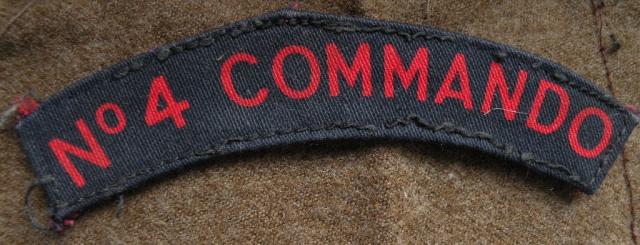4 Commando
Primary tabs

History of the Unit
No.4 Commando was formed on 23rd June 1940 and ‘commenced operations’ on 15th July the same year. On 22nd July 1940 the first full parade of No. 4 Commando was held in the old pavilion on the sea front at Weymouth and it was taken by the newly appointed Commanding Officer, Lt. Col. P. Legard.
After initial training stints in Scotland during 1940 the Commando became a part of 3 Special Service Battalion, Lt Col Dudley Lister MC replacing Lt Col Legard as Commanding Officer. They reverted back to No. 4 Commando on 26th of February 1941.
There were originally 10 troops. After the change from Special Service Battalions to full Commando, they reduced to 6 troops 'A' through to 'F'. After Normandy and before Walcheren a further change was made, and the troops were identified by number rather than letter. Early Operations included. 4th March 1941 ‘Claymore’ in the Lofoton Islands. 21/22nd April 1942 ‘Abercrombie’ at Hardelot Village.
No. 4 Commandos' task in the Dieppe raid on 19th August 1942 was to knock out the Gun Battery at Varengeville. Their success became a training book example of how to assault a static gun emplacement. Charismatic Commando leader Lt. Colonel The Lord Lovat was the C.O. for the two latter operations, Lt Col. Lister MC having now taken command of No.10 Commando. Losses at Dieppe were replaced by a fine entry of former police officers who were to win many Commandos’ respect for the high quality of men enlisted.
No 4’s Major Pat Porteus was awarded the Victoria Cross for his part in the operations. View the Dieppe Roll of Honour here [Dieppe ROH].
There then followed a period of intensive training. No. 4 was next in action in the allied invasion of North West Europe.
During the Normandy operations two troops of French Commando’s from No.10 Inter-allied Commando were transferred to operate with No 4 Commando, thus allowing French Nationals to be first ashore on the liberation of their own country. D-Day objectives for No. 4 Commando were to be the liberation of Ouistreham and to relieve the Airborne Units who had captured the Orne bridges. This was in tandem with other Commando units. An incident which took place at this point has passed into Commando folk lore. Lt. Colonel The Lord Lovat apologised to the C. O. of the Airborne troops for arriving at the point of rendezvous several minutes LATE!!
The last operation for No.4 Commando was its succesful role in the landings and subsequent assault on Flushing during Operation Infatuate between the 1st and 8th November 1944.
In June 1945 No 3 Commando, along with No 6 Commando, were back in the UK preparing for the planned invasion of the Japanese mainland. No 4 Commando were still in Germany at Recklinghausen. At this time 233 OR's from No.4 Commando were posted to Nos. 3 and 6 Commandos, to bolster their numbers for the invasion, however Japan surrendered and the war ended.
In September 1945 with the war over, No.4 Commando, still in Germany, were reinforced by Officers and men, with high release numbers, from Army Commandos in England which had no operational role or commitments. No one knew that a decision had been made to disband the Army Commandos, and no official or public announcement had been made. (Source: Major Jimmy Dunning)
The Commando was later disbanded along with all the other Army Commandos.
View our Gallery images of No 4 Commando
Click/touch No 4 Commando below for additional content, or follow the links below to specific content entries.
Ask Questions / Add Information / Add Photos
Read some frequently asked questions here [FAQ's].


